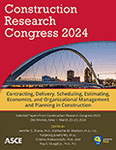New and Emerging Modularization Business Drivers in Industrial Projects
Publication: Construction Research Congress 2024
ABSTRACT
The prevalence of modular construction has sparked interest in understanding the industry’s new and emerging business drivers for modularization to seek maximum modularization benefits in capital projects. Previous studies on modularization business drivers have primarily focused on the building sector, with few addressing industrial projects. Additionally, these studies have been criticized for failing to address emerging issues such as sustainability and environmental, social, and governance (ESG) initiatives. To address these research gaps, this study identifies new and emerging business drivers for modularization in capital projects, mainly heavy industrial projects. A comprehensive analysis of existing business models/tools in the industry, followed by a literature review and brainstorming sessions with subject matter experts from the Construction Industry Institute Research Team 396, was conducted to gather all the potential business drivers for modularization. As a result, a total of 97 potential business drivers were identified. The subject matter experts assessed these drivers through a survey, indicating that sustainability, construction-related emissions and waste, ESG initiatives, transportation-related emissions and congestion, and standardization (repetitive design) are the new and emerging business drivers. This study offers valuable insights for practitioners seeking to analyze the potential of modularization ventures.
Get full access to this article
View all available purchase options and get full access to this chapter.
REFERENCES
Choi, J. O. (2014). Links between Modularization Critical Success Factors and Project Performance, Ph.D. Dissertation Austin (TX): The University of Texas at Austin. Available at: https://repositories.lib.utexas.edu/handle/2152/25030.
Choi, J. O., O’Connor, J. T., Kwak, Y. H., and Shrestha, B. K. (2019a). “Modularization Business Case Analysis Model for Industrial Projects.” J. Manage. Eng.,35(3). https://doi.org/10.1061/(ASCE)me.1943-5479.0000683.
Choi, J. O., Chen, X. B., and Kim, T. W. (2019b). Opportunities and challenges of modular methods in dense urban environment. International journal of construction management, 19(2), 93–105.
Choi, J. O., Shrestha, B. K., Kwak, Y. H., and Shane, J. S. (2020a). “Critical Success Factors and Enablers for Facility Design Standardization of Capital Projects.” J. Manage. Eng., 36(5).American Society of Civil Engineers. https://doi.org/10.1061/(ASCE)ME.1943-5479.0000788.
Choi, J. O., Shrestha, B. K., Shane, J. S., and Kwak, Y. H. (2020b). “Facility Design Standardization Decision-Making Model for Industrial Facilities and Capital Projects.” J. Manag. Eng., 36 (6). American Society of Civil Engineers. https://doi.org/10.1061/(ASCE)ME.1943-5479.0000842.
CII (Construction Industry Institute). (2023). Accessed May 10, 2023, from https://www.constructioninstitute.org/groups/research-teams/rt-396.
Darko, A., Zhang, C., and Chan, A. P. C. (2017). “Drivers for green building: A review of empirical studies.” Habitat International.,60:34–49.Elsevier Ltd. https://doi.org/10.1016/J.HABITATINT.2016.12.007.
Duncheva, T., and Bradley, F. F. (2019). “Multifaceted Productivity Comparison of Off-Site Timber Manufacturing Strategies in Mainland Europe and the United Kingdom.” J. Constr. Eng.Manage.,145(8).American Society of Civil Engineers. https://doi.org/10.1061/(ASCE)CO.1943-7862.0001641.
Greer, F., and Horvath, A. (2023). “Modular construction’s capacity to reduce embodied carbon emissions in California’s housing sector.” Build. Environ., 240: 110432. Pergamon. https://doi.org/10.1016/J.BUILDENV.2023.110432.
Hwang, B. G., Shan, M., and Looi, K. Y. (2018). “Knowledge-based decision support system for prefabricated prefinished volumetric construction.”Autom.Constr.,94:168–178. https://doi.org/10.1016/J.AUTCON.2018.06.016.
Ibrahim, I. H., Sorazan, W. M. F. W., and Wan Muhammad, W. M. N. (2022). “Transportation and Cost Issues in Modular Construction for IBS (Industrialized Building System).” Int. J. Acad. Res. Bus. Soc. Sci., 12(11), 1498–1508. https://doi.org/10.6007/ijarbss/v12-i11/15038.
International Energy Agency. (2019). 2019 Global Status Report for Buildings and Construction. www.iea.org.
Kamali, M., and Hewage, K. (2016). “Life cycle performance of modular buildings: A critical review.” Renew. Sustain. Energy Rev.,62:1171–1183. Elsevier Ltd. https://doi.org/10.1016/J.RSER.2016.05.031.
Kluck, M., and Choi, J. O. (2023). Modularization: The Fine Art of Offsite Preassembly for Capital Projects. John Wiley & Sons. First Ed.
Lawson, M., Ogden, R., and Goodier, C. (2014). Design in Modular Construction. CRC Press : Boca Raton, London, New York., Taylor & Francis Group. https://www.taylorfrancis.com/pdfviewer/.
Nabi, M. A., and El-Adaway, I. H. (2020). “Modular Construction: Determining Decision-Making Factors and Future Research Needs.” J. Manage. Eng., 36(6). American Society of Civil Engineers (ASCE).https://doi.org/10.1061/(ASCE)me.1943-5479.0000859.
O’Connor, J. T., O’Brien, W. J., and Choi, J. O. (2015a). “Standardization Strategy for Modular Industrial Plants.” J. Constr. Eng. Manage., 141(9). American Society of Civil Engineers (ASCE).https://doi.org/10.1061/(ASCE)CO.1943-7862.0001001.
O’Connor, J. T., O’Brien, W. J., and Choi, J. O. (2015b). “Industrial Project Execution Planning: Modularization versus Stick-Built.” Pract. Period. Struct. Des. Constr., 21 (1). American Society of Civil Engineers (ASCE). https://doi.org/10.1061/(ASCE).
Pan, W., Alistair, G. G. F., and Dainty, A. R. J. (2012). “Strategies for Integrating the Use of Off-Site Production Technologies in House Building.” J. Constr. Eng. Manage., 138(11). https://doi.org/10.1061/(ASCE)CO.
Pearce, A. R. (2008). “Sustainable capital projects: Leapfrogging the first cost barrier.” Civ. Eng. Environ. Syst., 25(4), 291–300. https://doi.org/10.1080/10286600802002973.
Rahman, M. M. (2014). “Barriers of Implementing Modern Methods of Construction.” J. Manage. Eng., 30(1), 69–77. https://doi.org/10.1061/(ASCE).
Wang, M., Wang, C. C., Sepasgozar, S., and Zlatanova, S. (2020). “A systematic review of digital technology adoption in off-site construction: Current status and future direction towards industry 4.0.” Buildings 2020., 10(11) pp: 1–29. https://doi.org/10.3390/buildings10110204.
Yunus, R., and Yang, J. (2012). “Critical sustainability factors in industrialized building systems.” Constr. Innovation., 12(4), 447–463. https://doi.org/10.1108/14714171211272216/FULL/PDF.
Information & Authors
Information
Published In
History
Published online: Mar 18, 2024
Authors
Metrics & Citations
Metrics
Citations
Download citation
If you have the appropriate software installed, you can download article citation data to the citation manager of your choice. Simply select your manager software from the list below and click Download.
